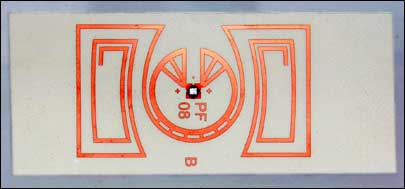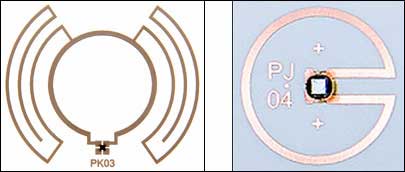Seattle-based RFID systems manufacturer Impinj says it is expanding its GrandPrix products to include inlays and interrogator antennas designed for item-level tagging. The GrandPrix line complies with EPCglobal‘s ultrahigh-frequency (UHF) Gen 2 air-interface standard. The new inlays contain Impinj’s Monza chip, are smaller than those made for conversion into smart labels and come in designs specific for tracking pharmaceuticals, apparel, CD/DVDs and other high-value and high-volume products. The interrogator antennas, customized for integration into shelving units to read individually tagged products, are being offered with the Impinj Speedway interrogator.
“Case-level and item-level tagging have different requirements,” says Impinj CEO Bill Colleran. Case tags need a long read range and high sensitivity, he explains, to be read at distance and overcome RF interference. Tags used at the item level, however, require less sensitivity because they are closer when read and within the interrogator’s range for a longer period of time. In addition, Colleran notes, since item-level tags need to be integrated into a product’s packaging or hangtags, they must be small.
Impinj has customized the inlays’ antennas so the inlays can be integrated into form factors such as garment hangtags, DVDs (either directly on the discs or on their packaging) and the packaging of items containing liquid or metals.
The antennas can be printed with conductive ink, etched from copper or stamped from aluminum. “Our designs comprise the geometry of the antenna, which can be made from any conductor,” says Colleran. “The performance of the antennas is not very sensitive to the resistance of the metal used, so in general, inlay manufacturers will migrate to the lowest-cost manufacturing process. Our new antennas for item-level tags can be used to create a range of tags, from as small as 9 mm tags that could be sewn into garment labels, to silver dollar-sized tags for things such as DVDs.”
Colleran says the new products will be commercially available in three to six months, but the company will be demonstrating the new inlays and antennas next week at the RFID World conference in Dallas. He adds that Impinj will also announce a number of industry partners with which it will bring the new tag and interrogator antennas to market.
Because Impinj is outsourcing the antenna and tag manufacturing to other firms, and because the material used to make the different antennas will affect the price, Colleran isn’t able to provide specific pricing information for tags made with the new antennas. He does, however, believe that because they are smaller and, therefore, have antennas with less metal, passive UHF tags made specifically for item-level tracking will cost 20 to 30 percent less than passive UHF RFID tags made for case and pallet tracking.
Impinj plans to submit inlays made with the new antennas, as well as the Impinj Speedway interrogator with new antennas for item-level tag reading, to a hardware-testing event EPCglobal will conduct next month. This testing will examine the performance of HF and UHF hardware systems in item-level tagging applications, including those being tested by the pharmaceutical industry. At the event, a number of RFID tag and interrogator manufacturers will test their products against a long list of requirements—read range, packaging materials and so forth—that manufacturers, distributors and other members of the pharmaceutical and retail supply chain have provided.
EPCglobal has established air-interface protocols for tags to identify consumer products at the case and pallet level, but has not yet developed any standards for item-level tags. There is some debate among tag manufacturers and RFID systems providers over whether UHF tags perform as well as HF tags for identifying products at the item level. “Our argument is that EPCglobal Gen 2 works at the item level with the right antenna,” says Colleran.




